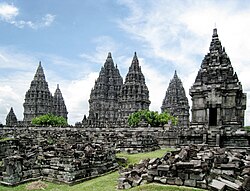| Prambanan Temple Compounds | |
|---|---|
 Prambanan, 2010 | |
| Location | Bokoharjo Village, Prambanan District, Sleman Regency, Special Region of Yogyakarta; and Bugisan Village, Prambanan District, Klaten Regency, Central Java |
| Coordinates | 7°45′8″S 110°29′30″E / 7.75222°S 110.49167°E |
| Built | Circa 8th to 9th century CE |
| Type | Cultural |
| Criteria | i, iv |
| Designated | 1991 (15th session) |
| Reference no. | 642 |
| Region | Southeast Asia |
Prambanan Temple Compounds is the World Heritage designation of a group of Hindu temple compounds that lie on the border between Yogyakarta and Central Java, Indonesia. It comprises Prambanan, Lumbung, Bubrah and Sewu temple compounds, all are located within Prambanan Archaeological Park.[1]
These temples are known locally as candi in Indonesian and Javanese languages. The temple compounds are located along Opak River valley within Prambanan Plain or Kewu Plain, an archaeologically rich area dotted with numerous Hindu temples dated from the 8th and 9th centuries CE, historically linked with the Mataram kingdom.[2] The diversity and sophistication of the temple compounds and archaeological sites in this area are comparable to Angkor archaeological site in Cambodia.
- ^ "Prambanan Temple Compounds". UNESCO World Heritage Centre. Archived from the original on 2020-01-14. Retrieved 2020-01-23.
- ^ Ramirez-Faria, Carlos (2007). Concise Encyclopedia Of World History. Atlantic Publishers & Dist. ISBN 978-81-269-0775-5. Archived from the original on 2021-11-10. Retrieved 2021-11-10.

